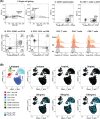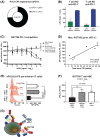A human receptor occupancy assay to measure anti-PD-1 binding in patients with prior anti-PD-1
- PMID: 33704890
- PMCID: PMC8451911
- DOI: 10.1002/cyto.a.24334
A human receptor occupancy assay to measure anti-PD-1 binding in patients with prior anti-PD-1
Abstract
Receptor occupancy (RO) assessment by flow cytometry is an important pharmacodynamic (PD) biomarker in the clinical development of large molecules such as monoclonal therapeutic antibodies (mAbs). The total-drug-bound RO assay format directly assesses mAb binding to cell surface targets using anti-drug detection antibodies. Here, we generated a flow cytometry detection antibody specifically binding to mAbs of the IgG1 P329GLALA backbone. Using this reagent, we developed a total-drug-bound RO assay format for RG7769, a bi-specific P329GLALA containing mAb targeting PD-1 and TIM3 on T cells. In its fit-for-purpose validated version, this RO assay has been used in the Phase-I dose escalation study of RG7769, informing on peripheral T cell RO and RG7769 antibody binding capacity (ABC). We assessed RG7769 RO in checkpoint-inhibitor (CPI) naïve patients and anti-PD-1 CPI experienced patients using our novel assay. Here, we show that in both groups, complete T cell RO can be achieved (~100%). However, we found that the maximum number of T cell binding sites for RG7769 pre-dosing was roughly twofold lower in patients recently having undergone anti-PD-1 treatment. We show that this is due to steric hindrance exerted by competing mAbs masking the available drug binding sites. Our findings highlight the importance of quantitative mAb assessment in addition to relative RO especially in the context of patients who have previously received anti-PD-1 treatment.
Keywords: PD biomarkers; PD-1; assay validation; checkpoint inhibitors; fit-for-purpose; flow cytometry; receptor occupancy; steric hindrance.
© 2021 The Authors. Cytometry Part A published by Wiley Periodicals LLC on behalf of International Society for Advancement of Cytometry.
Conflict of interest statement
All authors are current or former employees of F. Hoffmann‐La Roche Ltd and may own company stock. CK in addition discloses ownership of F. Hoffmann‐La Roche Ltd patents and stock.
Figures



Similar articles
-
Receptor occupancy assessment by flow cytometry as a pharmacodynamic biomarker in biopharmaceutical development.Cytometry B Clin Cytom. 2016 Mar;90(2):117-27. doi: 10.1002/cyto.b.21259. Epub 2015 Jul 31. Cytometry B Clin Cytom. 2016. PMID: 26054054 Free PMC article. Review.
-
Multiplexing of receptor occupancy measurements for pharmacodynamic biomarker assessment of biopharmaceuticals.Cytometry B Clin Cytom. 2016 Mar;90(2):128-40. doi: 10.1002/cyto.b.21319. Epub 2015 Oct 15. Cytometry B Clin Cytom. 2016. PMID: 26332491 Free PMC article.
-
A weighted method for estimation of receptor occupancy for pharmacodynamic measurements in drug development.Cytometry B Clin Cytom. 2016 Mar;90(2):220-9. doi: 10.1002/cyto.b.21277. Epub 2015 Aug 31. Cytometry B Clin Cytom. 2016. PMID: 26205127 Clinical Trial.
-
Role of receptor occupancy assays by flow cytometry in drug development.Cytometry B Clin Cytom. 2016 Mar;90(2):110-6. doi: 10.1002/cyto.b.21355. Epub 2016 Feb 16. Cytometry B Clin Cytom. 2016. PMID: 26704557 Review.
-
Receptor occupancy measurement of anti-PD-1 antibody drugs in support of clinical trials.Bioanalysis. 2019 Jul;11(14):1347-1358. doi: 10.4155/bio-2019-0090. Epub 2019 Aug 8. Bioanalysis. 2019. PMID: 31393160
Cited by
-
Development and pharmacokinetic assessment of a fully canine anti-PD-1 monoclonal antibody for comparative translational research in dogs with spontaneous tumors.MAbs. 2023 Jan-Dec;15(1):2287250. doi: 10.1080/19420862.2023.2287250. Epub 2023 Dec 4. MAbs. 2023. PMID: 38047502 Free PMC article.
-
Receptor occupancy assessment and interpretation in terms of quantitative systems pharmacology: nivolumab case study.MAbs. 2023 Jan-Dec;15(1):2156317. doi: 10.1080/19420862.2022.2156317. MAbs. 2023. PMID: 36524835 Free PMC article.
-
Multispecific Antibodies Targeting PD-1/PD-L1 in Cancer.BioDrugs. 2025 May;39(3):427-444. doi: 10.1007/s40259-025-00712-6. Epub 2025 Mar 19. BioDrugs. 2025. PMID: 40106158 Review.
-
Deciphering molecular and cellular ex vivo responses to bispecific antibodies PD1-TIM3 and PD1-LAG3 in human tumors.J Immunother Cancer. 2022 Nov;10(11):e005548. doi: 10.1136/jitc-2022-005548. J Immunother Cancer. 2022. PMID: 36319064 Free PMC article.
-
Outcomes and Adverse Events in Patients with Cancer after Diagnosis of Immunotherapy-Associated Diabetes Mellitus: A Retrospective Cohort Study.Cancers (Basel). 2024 Apr 25;16(9):1663. doi: 10.3390/cancers16091663. Cancers (Basel). 2024. PMID: 38730614 Free PMC article.
References
-
- Green CL, Stewart JJ, Hogerkorp CM, Lackey A, Jones N, Liang M, et al. Recommendations for the development and validation of flow cytometry‐based receptor occupancy assays. Cytometry B Clin Cytom. 2016;90:141–9. - PubMed
-
- Stevenson L, Richards S, Pillutla R, Torri A, Kamerud J, Mehta D, et al. 2018 White Paper on Recent Issues in Bioanalysis: focus on flow cytometry, gene therapy, cut points and key clarifications on BAV (part 3—LBA/cell‐based assays: immunogenicity, biomarkers and PK assays). Bioanalysis. 2018;10:1973–2001. - PubMed
-
- Stewart JJ, Green CL, Jones N, Liang M, Xu Y, Wilkins DE, et al. Role of receptor occupancy assays by flow cytometry in drug development. Cytometry B Clin Cytom. 2016;90:110–6. - PubMed
-
- Gunn GR, Evans C, Yang E. Immunogenicity and biomarkers: bioanalytical challenges and considerations. Bioanalysis. 2017;9:1729–32. - PubMed
Publication types
MeSH terms
Substances
Grants and funding
LinkOut - more resources
Full Text Sources
Other Literature Sources
Research Materials

